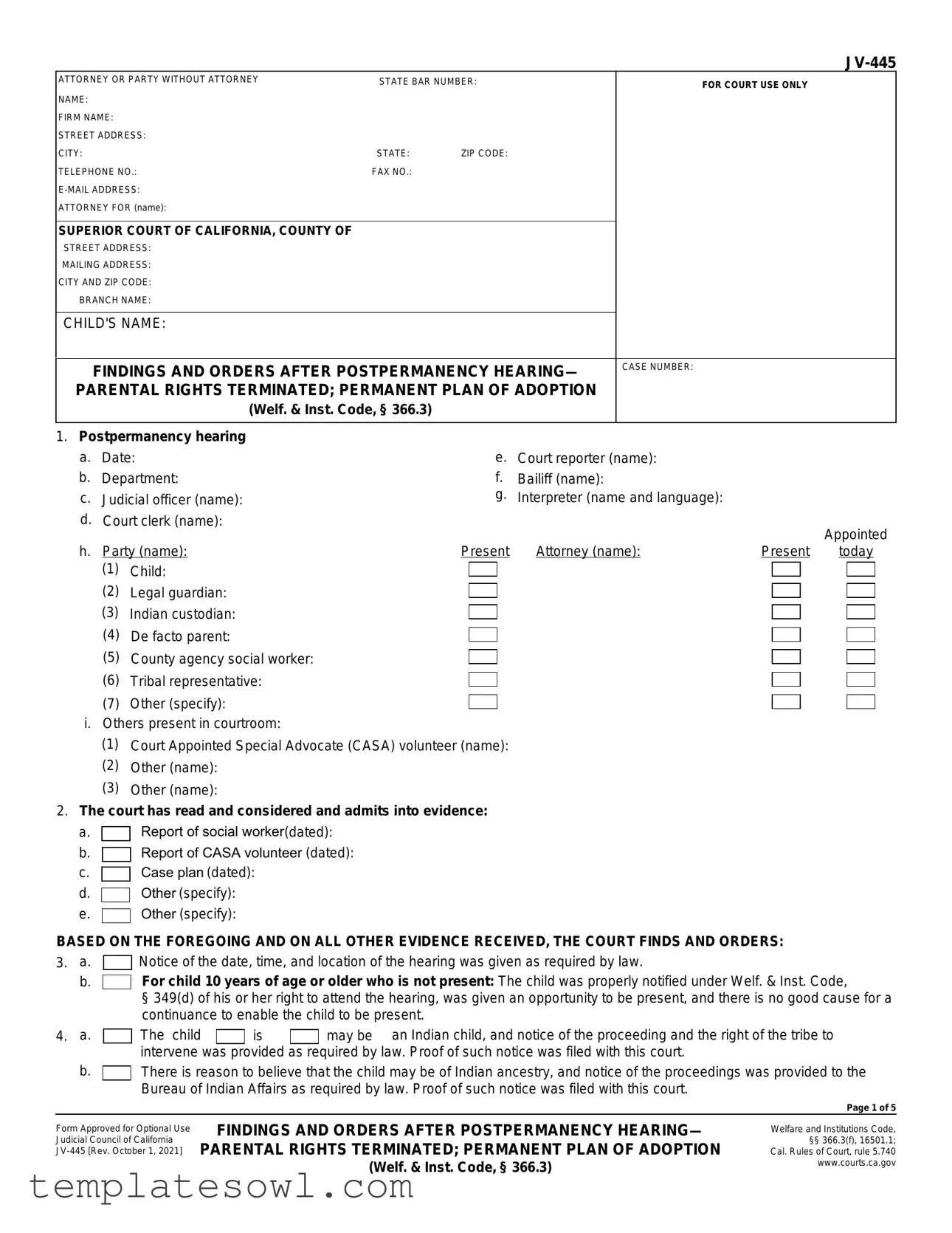Filling out the California JV-445 form can be a complex task, and it’s crucial to avoid mistakes that could delay proceedings or negatively impact a child's welfare. One common error is failing to include all necessary parties in the notifications. Ensuring that everyone who needs to be aware of the hearing—such as guardians, social workers, and relevant family members—is notified is vital. Omissions can lead to challenges in proceedings and may affect the outcome for the child.
Another frequent mistake involves not providing accurate dates. The JV-445 form requires specific dates, such as the date of the postpermanency hearing and the date of relevant evidence submissions. Any inaccuracy here can create confusion and complicate legal processes. Always double-check dates before submitting the form.
Underestimating the importance of documentation is another pitfall. The court relies on evidence to make informed decisions, so it's essential to indicate all evidence considered during the hearing. Missing reports from social workers or CASA volunteers can undermine the court's understanding of the child's situation. Thus, always list and attach necessary documents to avoid unnecessary delays.
Poor organization also plays a role in errors. The JV-445 form has various sections that require precise information. Jumping around or filling things out out of order can lead to incomplete responses or missed questions. To combat this, complete the form systematically, following each section sequentially.
People frequently overlook the need for signatures and initials. Every party involved should provide the necessary signatures to affirm the information presented. A lacking signature can stall processes and create legal hiccups. Prior to submission, review the entire form to ensure all required signatures are present.
In addition, miscommunication about the child's involvement in the case plan is a recurring issue. If the child is of an age where they should be involved in their case plans, it is crucial to accurately report their participation. Not documenting a child's involvement—or indicating they were not involved when they should have been—can lead to further legal ramifications.
Another frequent oversight is not providing complete contact information. Accurate details for all parties—including addresses, phone numbers, and emails—are essential for facilitating communication. A lack of accurate contact information can impede the legal process and prevent the court from reaching the correct parties promptly.
Filing the JV-445 form without proper consideration of deadlines is also problematic. Each section might require specific timing for submissions, especially in relation to hearings and evaluations. Missing a deadline can hinder the progress of a child's case and may result in adverse consequences.
Lastly, individuals sometimes neglect to clarify the child's needs regarding health and education. Each item related to the child’s educational placement and health services must be accurately reported to ensure that all needs are addressed. Failing to provide this information can lead to significant delays in necessary services being provided to the child.


 Report of social worker
Report of social worker Report of CASA volunteer
Report of CASA volunteer  Case plan
Case plan 


 Notice of the date, time, and location of the hearing was given as required by law.
Notice of the date, time, and location of the hearing was given as required by law.
 The child's current placement is appropriate.
The child's current placement is appropriate.




 The child is placed outside the state of California and that
The child is placed outside the state of California and that 
 continues to be the most appropriate placement for the child and is in the best interest of the child.
continues to be the most appropriate placement for the child and is in the best interest of the child.
 returning the child to California and locating an appropriate placement within California.
returning the child to California and locating an appropriate placement within California.




 Child 12 years of age or older:
Child 12 years of age or older:
 The child was given the opportunity to review the case plan, sign it, and receive a copy.
The child was given the opportunity to review the case plan, sign it, and receive a copy.
 The child was not given the opportunity to review the case plan, sign it, and receive a copy, and
The child was not given the opportunity to review the case plan, sign it, and receive a copy, and
 has has not
has has not

 Child not yet placed with prospective adoptive parent or a guardian
Child not yet placed with prospective adoptive parent or a guardian has with the child's best interest.
has with the child's best interest.



 as stated on the record. as follows:
as stated on the record. as follows:
 as stated on the record. as follows:
as stated on the record. as follows:
 adequate. not adequate.
adequate. not adequate.
 The additional services, assessments, and/or evaluations the child requires to meet the unmet needs specified in item 17 or other concerns are:
The additional services, assessments, and/or evaluations the child requires to meet the unmet needs specified in item 17 or other concerns are:
 stated in the social worker's report.
stated in the social worker's report.
 specified here:
specified here:
 The following persons are ordered to take the steps necessary for the child to begin receiving the services, assessments, and/or evaluations identified in item 19:
The following persons are ordered to take the steps necessary for the child to begin receiving the services, assessments, and/or evaluations identified in item 19:
 Social worker.
Social worker.
 Surrogate parent
Surrogate parent 
 Educational representative
Educational representative 
 Other
Other 

 The child's education placement has changed since the last review hearing.
The child's education placement has changed since the last review hearing.
 The child's educational records, including any evaluation regarding a disability, were requested by the child's new school within two business days of the request to enroll and those records were provided by the child's former school to the child's new school within two business days of the receipt of the educational records request.
The child's educational records, including any evaluation regarding a disability, were requested by the child's new school within two business days of the request to enroll and those records were provided by the child's former school to the child's new school within two business days of the receipt of the educational records request.
 The child is enrolled in school.
The child is enrolled in school.
 The child is attending school.
The child is attending school.
 Child 14 years of age or older:
Child 14 years of age or older:


 The child does not have siblings under the court's jurisdiction.
The child does not have siblings under the court's jurisdiction.
 a. The permanent plan of adoption is appropriate and is ordered to continue as the permanent plan.
a. The permanent plan of adoption is appropriate and is ordered to continue as the permanent plan.
 a. The permanent plan of tribal customary adoption is appropriate and is ordered to continue as the permanent plan.
a. The permanent plan of tribal customary adoption is appropriate and is ordered to continue as the permanent plan.
 a. The child's permanent plan of adoption may or may not be appropriate, and the matter is ordered set for a hearing under Welf. & Inst. Code, § 366.26 to select the most appropriate permanent plan for the child. The county agency and the licensed county adoption agency or the California Department of Social Services, acting as an adoption agency, will prepare and serve an assessment report as described in Welf. & Inst. Code, § 366.22(b).
a. The child's permanent plan of adoption may or may not be appropriate, and the matter is ordered set for a hearing under Welf. & Inst. Code, § 366.26 to select the most appropriate permanent plan for the child. The county agency and the licensed county adoption agency or the California Department of Social Services, acting as an adoption agency, will prepare and serve an assessment report as described in Welf. & Inst. Code, § 366.22(b).


 Visitation Attachment: Parent, Legal Guardian, Indian Custodian, Other Important Person
Visitation Attachment: Parent, Legal Guardian, Indian Custodian, Other Important Person 
 Visitation Attachment: Sibling
Visitation Attachment: Sibling 
 Visitation Attachment: Grandparent
Visitation Attachment: Grandparent 

 Other findings and orders:
Other findings and orders:
 See attached.
See attached.
 (Specify):
(Specify):
 The next hearing is scheduled as follows:
The next hearing is scheduled as follows: